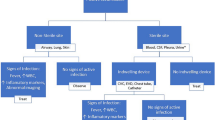Abstract
Improvements in the exit-site care for peritoneal dialysis (PD) patients have uncovered a trend for increasing incidence of rapidly growing nontuberculous mycobacterium exit-site infections (ESI). Among these, Mycobacterium abscessus is unique in terms of its high morbidity and treatment failure rates. The international society of PD guidelines encourage PD catheter removal in patients with M. abscessus peritonitis but, do not have evidence-based recommendations for the management of ESIs related to this organism. We report an unusual case in which an asymptomatic end-stage renal disease patient with multiple favorable clinical characteristics, i.e., no apparent immunodeficiency, sensitivity pattern showing possibility of treatment with multiple antibiotics, no evidence of peritonitis, and early clinical response, was treated with a 9-month combination antimicrobial regimen administered orally and intraperitoneally. Despite excellent clinical response with a resolution of the ESI, our patient relapsed quickly, within 30 days of stopping antimicrobial therapy and required PD catheter removal. Our case, taken together with available published case reports, highlights the futility of the conservative approach towards the M. abscessus ESI and makes the cases for early PD catheter removal in these patients.


Similar content being viewed by others
References
Shen JI, Mitani AA, Saxena AB, Goldstein BA, Winkelmayer WC. Determinants of peritoneal dialysis technique failure in incident US patients. Perit Dial Int. 2013;33(2):155–66. https://doi.org/10.3747/pdi.2011.00233.
Szeto CC, Li PKT, Johnson DW, Bernardini J, Dong J, Figueiredo AE, et al. ISPD catheter-related infection recommendations: 2017 update. Perit Dial Int. 2017;37(2):141–54. https://doi.org/10.3747/pdi.2016.00120.
Singh H, Saha T. Exit-site infection due to nontubercular Mycobacteria in an immunocompromised peritoneal dialysis patient. Dialysis & Transplantation. 2008;37(10):401–9. https://doi.org/10.1002/dat.20225.
Mooren V, Bleeker MWP, van Ingen J, Hermans MHA, Wever PC. Disseminated Mycobacterium abscessus infection in a peritoneal dialysis patient. IDCases. 2017;9:6–7. https://doi.org/10.1016/j.idcr.2017.05.001.
Yoshimura R, Kawanishi M, Fujii S, Yamauchi A, Takase K, Yoshikane K, et al. Peritoneal dialysis-associated infection caused by Mycobacterium abscessus: a case report. BMC Nephrol. 2018;19(1):341. https://doi.org/10.1186/s12882-018-1148-2.
Renaud CJ, Subramanian S, Tambyah PA, Lee EJ. The clinical course of rapidly growing nontuberculous Mycobacterial peritoneal dialysis infections in Asians: a case series and literature review. Nephrology (Carlton). 2011;16(2):174–9. https://doi.org/10.1111/j.1440-1797.2010.01370.x.
Lo MW, Mak SK, Wong YY, Lo KC, Chan SF, Tong GM, et al. Atypical Mycobacterial exit-site infection and peritonitis in peritoneal dialysis patients on prophylactic exit-site gentamicin cream. Perit Dial Int. 2013;33(3):267–72. https://doi.org/10.3747/pdi.2011.00184.
Bernardini J, Bender F, Florio T, Sloand J, Palmmontalbano L, Fried L, et al. Randomized, double-blind trial of antibiotic exit site cream for prevention of exit site infection in peritoneal dialysis patients. J Am Soc Nephrol. 2005;16(2):539–45. https://doi.org/10.1681/ASN.2004090773.
Petrini B. Mycobacterium abscessus: an emerging rapid-growing potential pathogen. APMIS. 2006;114(5):319–28. https://doi.org/10.1111/j.1600-0463.2006.apm_390.x.
Macheras E, Roux A-L, Bastian S, Leão SC, Palaci M, Sivadon-Tardy V, et al. Multilocus sequence analysis and rpoB sequencing of Mycobacterium abscessus (sensu lato) strains. J Clin Microbiol. 2011;49(2):491–9. https://doi.org/10.1128/JCM.01274-10.
Tsai S-F. Catheter related infection due to Mycobacterium abscessus in a patient under peritoneal dialysis. Therapeutic Apheresis and Dialysis. 2013;17(3):349–50. https://doi.org/10.1111/1744-9987.12005.
Tse KC, Lui SL, Cheng VC, Yip TP, Lo WK. A cluster of rapidly growing Mycobacterial peritoneal dialysis catheter exit-site infections. Am J Kidney Dis. 2007;50(1):e1–5. https://doi.org/10.1053/j.ajkd.2007.04.017.
Jiang SH, Roberts DM, Clayton PA, Jardine M. Non-tuberculous Mycobacterial PD peritonitis in Australia. Int Urol Nephrol. 2013;45(5):1423–8. https://doi.org/10.1007/s11255-012-0328-4.
Griffith DE, Aksamit T, Brown-Elliott BA, Catanzaro A, Daley C, Gordin F, et al. An official ATS/IDSA statement: diagnosis, treatment, and prevention of nontuberculous Mycobacterial diseases. Am J Respir Crit Care Med. 2007;175(4):367–416. https://doi.org/10.1164/rccm.200604-571ST.
Ono E, Uchino E, Mori KP, Yokoi H, Toda N, Koga K, et al. Peritonitis due to Mycobacterium abscessus in peritoneal dialysis patients: case presentation and mini-review. Ren Replace Ther. 2018;4(1):52. https://doi.org/10.1186/s41100-018-0192-5.
Kameyama H, Mori Y, Kimura T, Sugishita C, Adachi T, Sonomura K, et al. A case report of Mycobacterium abscessus peritonitis in a peritoneal dialysis patient. Ther Apher Dial. 2007;11(6):449–51. https://doi.org/10.1111/j.1744-9987.2007.00526.x.
Acknowledgements
We would like to thank Dr. Kevin Fennelly (Senior Research Clinician, Laboratory of Chronic Airway Infection, Pulmonary Branch, Division of Intramural Research. National Institutes of Health) for his input on M. abscessus infection management.
Funding
A. M. Shukla reports the ongoing grant support from the Department of Veterans Affairs. The grant support is unrelated to and has no conflicts with the work published here.
Author information
Authors and Affiliations
Corresponding author
Ethics declarations
Conflict of interest
The authors have declared no conflict of interest exists.
Ethical standards
This article does not contain any studies with human participants or animals performed by any of the authors.
Informed consent
Informed consent was obtained from all individuals participants included in the study.
Additional information
Publisher's Note
Springer Nature remains neutral with regard to jurisdictional claims in published maps and institutional affiliations.
About this article
Cite this article
Chamarthi, G., Kamboj, M., Archibald, L.K. et al. Mycobacterium abscessus exit-site infection in peritoneal dialysis patients: should we ever aim to salvage the catheter?. CEN Case Rep 10, 12–16 (2021). https://doi.org/10.1007/s13730-020-00506-5
Received:
Accepted:
Published:
Issue Date:
DOI: https://doi.org/10.1007/s13730-020-00506-5




